Family name: Butomaceae Mirbel
Synonym(s): [none]
Common name(s): flowering-rush family
*Number of genera/species: 1/1
List of generic records in GRIN-Global
seed
Fruit a follicle usually aggregateaggregate:
fruit formed from a single flower with carpels several and distinct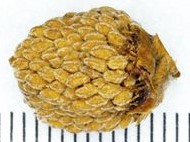 , 10 mm long, teardrop shapedteardrop-shaped:
, 10 mm long, teardrop shapedteardrop-shaped:
2D shape—widest point is toward one end of the fruit, the other end tapers sharply to a pointed end , beakedbeak:
, beakedbeak:
a usually firm, terminal appendage, sometimes tapered , with many seeds. Pericarppericarp:
, with many seeds. Pericarppericarp:
fruit wall or fruit coat
brown to nearly black, leatheryleathery:
texture—moderately thick, tough, and very pliable
, smooth.
Seeds oblongoblong:
2D shape—much longer than broad with nearly parallel sides, corners are rounded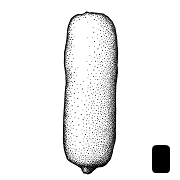 , tereteterete:
, tereteterete:
approximately circular in cross section; width and thickness approximately equal
 in transection, 2 mm long. Seed coat brown, membranousmembranous:
in transection, 2 mm long. Seed coat brown, membranousmembranous:
texture—extremely thin, pliable, and fairly tough
, glabrousglabrous:
without hairs
, distinctly longitudinally ribbedribbed:
surface relief—wide, prominent, linear ridges that are generally rounded and longitudinally situated on the surface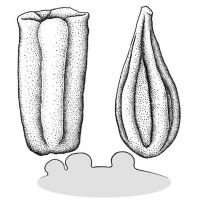 , may also appear wrinkledwrinkled:
, may also appear wrinkledwrinkled:
surface relief—shallow, irregular folds and furrows covering the surface; appearing overall though crumpled and then spread out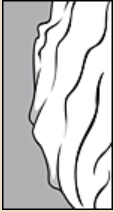 or striatestriate:
or striatestriate:
surface relief—having fine, parallel lines, grooves or ridges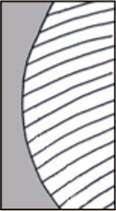 . (Note, dried seeds do not germinate.)
. (Note, dried seeds do not germinate.)
Embryo rudimentaryrudimentary:
(of embryo) embryo is small and fills less than a quarter of the seed and can be variable in shapes, such as linear, spatulate, or oval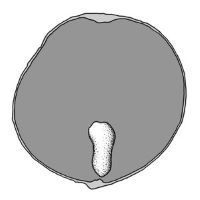 , linearlinear:
, linearlinear:
(shape) long, narrow, and uniform in width; (of embryo) embryo is straight and much longer than wide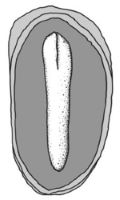 , straight.
, straight.
Endosperm lacking.
Butomus umbellatus is an aquatic state noxious weed in Connecticut, Minnesota, New Hampshire, Vermont, and Washington.
Aquarium & Pond Plants of the World tool includes descriptions and images of Butomus.
| Fruit | |
| Type | folliclefollicle: a dry to (rarely) fleshy fruit derived from a single carpel that opens along a single longitudinal suture, derived from a single, superior, simple ovary; the seeds may be arillate or with a fleshy testa  |
| Size range | 10 mm long |
| Shape(s) | teardrop-shapedteardrop-shaped: 2D shape—widest point is toward one end of the fruit, the other end tapers sharply to a pointed end  |
| Texture | leatheryleathery: texture—moderately thick, tough, and very pliable |
| Surface relief | smooth |
| Color(s) | brown, black |
| Unique features | Small, teardrop-shapedteardrop-shaped: 2D shape—widest point is toward one end of the fruit, the other end tapers sharply to a pointed end  aggregateaggregate: aggregateaggregate:fruit formed from a single flower with carpels several and distinct  of folliclesfollicle: of folliclesfollicle:a dry to (rarely) fleshy fruit derived from a single carpel that opens along a single longitudinal suture, derived from a single, superior, simple ovary; the seeds may be arillate or with a fleshy testa  with longitudinally ribbedribbed: with longitudinally ribbedribbed:surface relief—wide, prominent, linear ridges that are generally rounded and longitudinally situated on the surface  seeds. seeds. |
| Seed | |
| Size range | 2 mm long |
| Shape(s) | oblongoblong: 2D shape—much longer than broad with nearly parallel sides, corners are rounded  |
| Surface relief | longitudinally ribbedribbed: surface relief—wide, prominent, linear ridges that are generally rounded and longitudinally situated on the surface  |
| Color(s) | brown |
| Other | |
| Embryo | rudimentaryrudimentary: (of embryo) embryo is small and fills less than a quarter of the seed and can be variable in shapes, such as linear, spatulate, or oval  , linearlinear: , linearlinear:(shape) long, narrow, and uniform in width; (of embryo) embryo is straight and much longer than wide  , straight , straight |
| Nutritive tissue | endosperm lacking |
Temperate regions of Eurasia and North Africa, naturalized in northern North America.
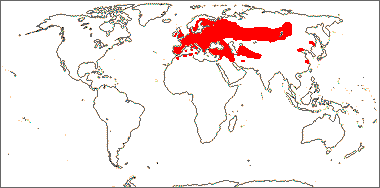
Distribution map courtesy of Angiosperm Phylogeny Website.
Baskin and Baskin 2021Baskin and Baskin 2021:
Baskin C and Baskin J. 2021. Relationship of the lateral embryo (in grasses) to other monocot embryos: A status up-grade. Seed Science Research 31 (3): 199-210. doi:10.1017/S0960258521000209; Dahlgren et al. 1985Dahlgren et al. 1985:
Dahlgren RMT, Clifford HT, and Yeo PF. 1985. The families of the monocotyledons: structure, evolution, and taxonomy. Springer-Verlag, Berlin. 520 pp.; Flora of North America Editorial Committee 1993+Flora of North America Editorial Committee 1993+:
Flora of North America Editorial Committee, eds. 1993+. Flora of North America North of Mexico [Online]. 22+ vols. Flora of North America Association, New York and Oxford. Accessed January-March 2024. URL: http://beta.floranorthamerica.org.; Kirkbride et al. 2006Kirkbride et al. 2006:
Kirkbride JH, Jr, Gunn CR, and Dallwitz MJ. 2006. Family guide for fruits and seeds, vers. 1.0. Accessed September 2020-January 2022. URL: https://nt.ars-grin.gov/seedsfruits/keys/frsdfam/index.cfm .; Kubitzki et al. 1990+Kubitzki et al. 1990+:
Kubitzki K et al., eds. 1990+. The families and genera of vascular plants. 7+ vols. Berlin etc.; Stevenson and Loconte 1995Stevenson and Loconte 1995:
Stevenson DW and Loconte H. 1995. A cladistic analysis of monocot families. In: Rudall PJ, Cribb PJ, Cutler DF, and Humphries CJ, eds. Monocotyledons: Systematics and Evolution. Royal Botanic Gardens, Kew.; Takhtajan 2009Takhtajan 2009:
Takhtajan A. 2009. Flowering plants: Second edition. Springer Nature, Switzerland. 871 pp.; Tutin et al. 1964–1980Tutin et al. 1964–1980:
Tutin TG, Burges NA, Chater AO, Edmondson JR, Heywood VH, Moore DM, Valentine DH, Walters SM, and Webb DA (eds.) 1964–1980. Flora Europaea. 5 vols. Cambridge University Press, Cambridge UK. 2,524 pp.; Watson and Dallwitz 1992+Watson and Dallwitz 1992+:
Watson L and Dallwitz MJ. 1992+. The families of flowering plants: descriptions, illustrations, identification, and information retrieval. Version: 6th Accessed September 2020-September 2022. URL: delta-intkey.com
*The number of genera and species is based on Christenhusz and Byng 2016Christenhusz and Byng 2016:
Christenhusz MJM and Byng JW. 2016. The number of known plant species in the world and its annual increase. Phytotaxa 261 (3): 201-217. https://doi.org/10.11646/phytotaxa.261.3.1, which may differ from the number of genera in GRIN-Global.